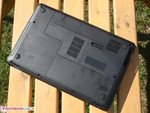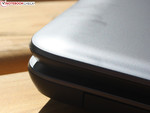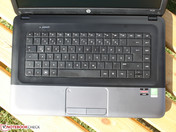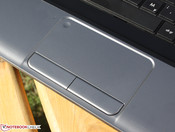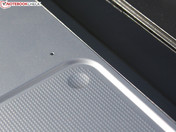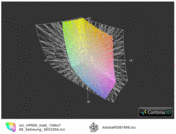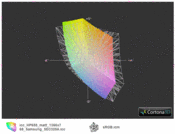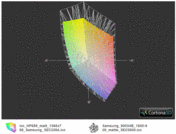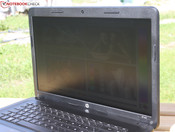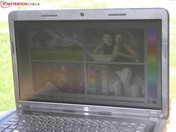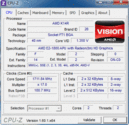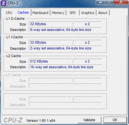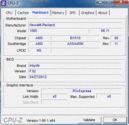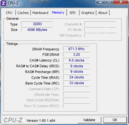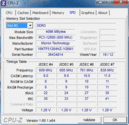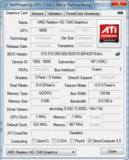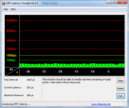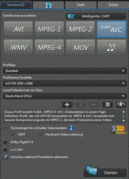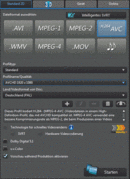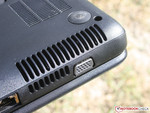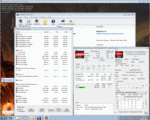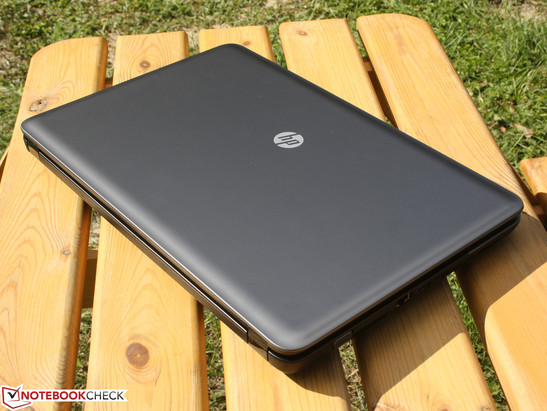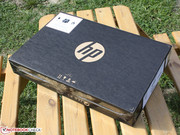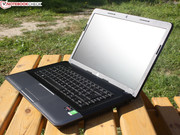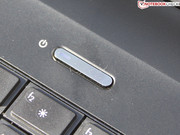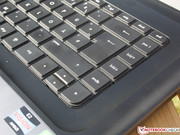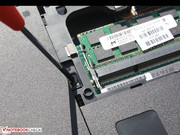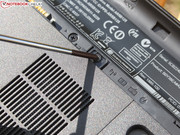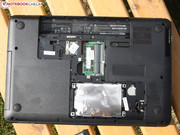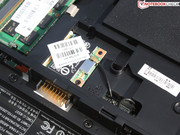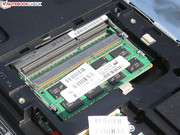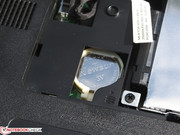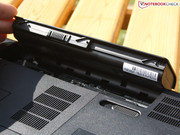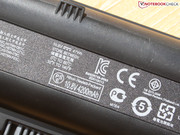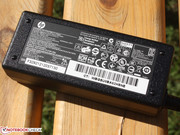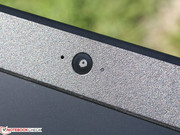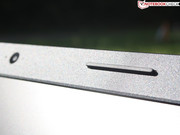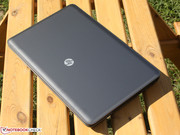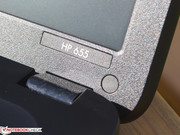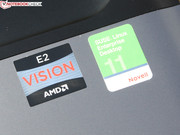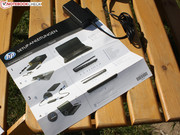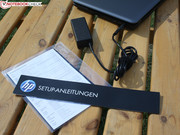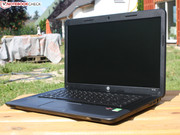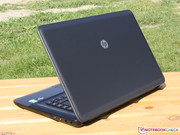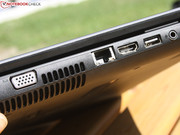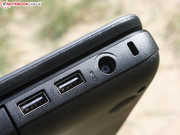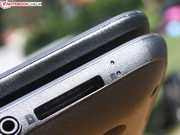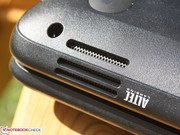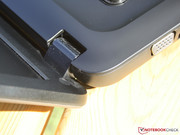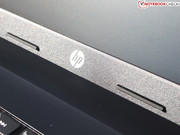Review HP 655 B6M65EA Notebook

Who doesn't like a bargain? And how much can you get for less than 300 Euros (~$386)? HP has the 6xx-series in their portfolio to compete in the bargain-basement segment. The 620, 625 (2009-2010), 630 and 635 (2011-2012) models were the previous HP contenders vying for the low-budget buyer.
The new HP 655 is an update of the 635. The five at the end of the model number indicates the maker of the CPU - in this case AMD. The HP 650 uses the (generally more expensive) Intel CPUs (Pentium B970 or Celeron B820). With prices starting at 335 Euros (~$431), the bargain hunter might wonder: AMD or Intel? Our test system comes equipped with AMDs new E2-1800 APU (2 x 1.70GHz) and a Radeon HD 7340 (IGP). In our review, we will help potential buyers with their decision-making process and pitch the two platforms against each other. We will also take a look at the low-priced offerings from the other manufacturers.
Case
The chassis of the HP 655 is made entirely out of plastic. The surfaces are treated differently: some areas are plain and textured (base unit, display frame), others are smooth and painted (palm rest, keyboard frame and display lid). The painted surfaces feel nice and are not prone to fingerprints. We seriously doubt that the palm rest is scratch resistant, as this would require the use of colored plastic during the manufacturing process. We expect the paint to scuff at the edges sooner or later.
The notebook features a slightly wedge-shaped base unit, seems sturdy and quite suitable for daily use. The 15.6-inch laptop weights in at 2.3 kilograms (5.07 pounds) and can't be considered a lightweight. The notebook is sufficiently solid and should hold up during repeated mobile use. We wouldn't recommend applying too much physical force, as neither the chassis nor the lid is torsionally very rigid. The hinges are solid and well-connected to the base unit. They are quite tight, however - we had to use both hands to open the display (up to a maximum of 135 degrees). The lid moves back and forth ever so slightly.
The gaps are sufficiently even, the parts molded cleanly, and everything is put together nicely. The palm rest is well supported and solid - only one area under the number keys flexes slightly.
The display lid is somewhat easy to twist (up to a certain limit) and flexes when pressure is applied in the middle. The hinges are attached securely and allow the display to be opened up to a maximum of 135 degrees, which is sufficient for working with the notebook on the lap.
The battery can be unlocked and removed with one hand. Since the battery doesn't tilt the laptop and doesn't feature rubber feet, it's possible to operate the HP 655 on a desk without the battery inserted. The rubber pads on the bottom of the laptop are both large and soft and don't allow the laptop to wobble or slide around. When we applied pressure, we were only able to deform the bottom of the laptop in the area of the DVD optical drive and under the fan vent.
There are two covers on the underside that allow the user to upgrade the notebook. In order to remove the covers, the battery has to be taken out (screws are now visible) and one screw for each cover needs to be removed. The following items can be replaced/upgraded: 2.5-inch hard disk drive, RAM (DDR3 SDRAM, one slot open), CMOS battery, and WLAN module (Mini PCI-Express Half Size).
Connectivity
Most of the ports are located on the left side of the chassis near the vent. Available are an Ethernet port, a VGA/HDMI port for an external display, and one USB 2.0 port. An ExpressCard34 slot (standard equipment on the 620/625) is not available any longer. Considering the price, the HDMI port should not be taken for granted. After all - the low-cost Acer Aspire 5250 doesn't have one. The card reader can handle SD, SDHC, and MCC cards. An inserted card only protrudes a couple of millimeters, so there is little chance of breakage. HP doesn't ship a plastic-dummy card (to protect the slot from dust) - not a big deal since those get lost anyway.
There are no ports on the back. If the notebook is used on the table with an external monitor, speakers, and USB devices hooked up, the unwieldy HDMI cable and the long audio connectors get in the way - at the very least, they are an optical nuisance. At least the ports on the right side (2 x USB and the power jack) are located towards the back. The MSI CR360 is a low-cost model which has most ports on the back - a commendable solution.
Communication
Draft N wireless and Gigabit LAN (both modules are sourced from Realtek) are pretty much standard fare nowadays. A Bluetooth module is not available. The webcam has a resolution of 640x480 pixels and features a white status LED. The 0.3 megapixel resolution is the bare minimum current laptops ship with. HP does not offer any webcam-specific software on their website. Software like Skype (video conferencing) or CyberLinks Power Director 8 (for benchmarks, video editing, and rendering) recognized the camera without a problem.
Software
Bargain hunters and those opposed to Windows will be interested in the low-cost version of the HP 655 with SUSE Linux. Even though we also decided on the version with Linux, we didn't actually try it out, since our test procedures are based on Windows. For that reason, we installed Windows 7 Ultimate 64-bit and downloaded all necessary drivers from the HP support website. We were able to find all drivers, but installing each one individually got cumbersome quite quickly. Lenovo allows their customer to create a download packet, which then can be loaded as a bundle.
One advantage of the time intensive procedure: our HP 655 ended up without any bloatware, trial software, and unnecessary tools. Software for creating a system image after the completed install is not available on the support website, so the user has to look elsewhere.
Accessories
HP didn't include a driver DVD. This can be an advantage, as the user is forced to install the latest and greatest drivers. The only other items in the box are a warranty card and a QuickStart guide.
Maintenance
The two covers at the bottom allow access to HDD, WLAN, CMOS battery, and RAM (two slots). Unfortunately the fan system cannot be accessed and cleaned.
Warranty
The standard warranty is a 12-month Pickup and Return Service. The shipping costs are the responsibility of the customer. Care Packs for 3 years of in-home service (next business day) are available for about 160 Euros (~$206). 3 years of Pickup and Return Service are a less expensive option (80 Euros/~$103).
Input Devices
Keyboard
The keys have good travel and clear tactile feedback. The clicking sound is soft and unobtrusive. There is no keyboard flex except a very minor softness in the area around the DVD drive. The reason the typing experience doesn't entirely satisfy: the keys are completely flat (not concave), which makes fluent typing somewhat difficult. In addition, the keys are mounted somewhat loosely, which makes finding the type position difficult when sliding the fingers across the keyboard.
We like the lighted Caps Lock and the WLAN keys. A little LED indicates when Caps Lock is on, which makes it easy to identify.
They keyboard of the HP 655 is fairly large so there was not enough room to incorporate a dedicated number block. The right side of the keyboard is home only to the PgUp, PgDn, Del, Home, and End keys, which are easy to find even when touch-typing. The shape of the keys (which feature a base) has not been modified since the HP 620/625 series. The layout now includes a larger right Shift-key. The HP 630/635 series features the same keyboard as our HP 655.
While the keyboard is a good fit for a "consumer" business user, for a true business laptop both feedback and accuracy would have to be a bit better.
Touchpad
The touchpad is a multi-touch Synaptics V7.7. The surface is slightly recessed and rough (textured). The mouse buttons feature the same surface as the surrounding palm rest. The textured surface of the touchpad gives good feedback and allows for a speedy cursor movement. A vertical scrollbar (not marked) can be activated if so desired; a horizontal bar is not available, since two fingers can be used instead.
PalmCheck can automatically deactivate the pad if the heel of the hand is detected during typing. The touchpad can be turned off via a double-click in a recessed area in the upper left (a little LED lights up when the touchpad is off).
The buttons are pretty loud, have little travel, and require a lot of pressure - exactly the opposite of what a good button design should be like. As far as overall feedback is concerned, the touchpad just can't compare to one installed in a ProBook or EliteBook.
Display
The HD panel (AUO B156XW02 V3) features a resolution of 1366x768 pixels (16:9). It's a non-glare type which should make the business user happy: no reflections! The contrast is extremely low at 118:1 - but this is typical for the price category and simple business laptops. We measured the black point at 1.4 cd/m². The blacks are therefore not truly black; a gray cast is always noticeable. Colors are dull and washed out.
As far as the reference color spaces are concerned, the AUO panel doesn't fare very well. It manages to cover only about half of Adobe RGB. Things look better with sRGB, but are still far from perfect. We do have to note here that we have not seen a laptop in this price range yet that did much better. Not that it really matters - it's mostly the professionals working on workstations that worry about such things.
| |||||||||||||||||||||||||
Brightness Distribution: 90 %
Center on Battery: 165 cd/m²
Contrast: 118:1 (Black: 1.4 cd/m²)
52.9% AdobeRGB 1998 (Argyll 3D)
73.9% sRGB (Argyll 3D)
51.2% Display P3 (Argyll 3D)
Those tempted to use the HP 655 outside in sunlight won't be very pleased. The 15.6-inch panel is non-glare (as we mentioned before) but the brightness is just too low (below average). 162 cd/m² is not nearly enough - somewhere around 250 cd/m² would be much better. Both in direct and indirect daylight the desktop is too dark - which is very straining and tiring for the eyes.
Inside the brightness is sufficient - as long as the desk is not located directly next to a light-flooded window. Since the display is a LED-backlit LCD, deterioration in quality (like seen with previous technologies) is not to be expected.
The very shallow viewing angles are another strike against the AUO panel. Horizontal angles of more than 40 degrees cause color changes and a decrease in brightness. The same negative changes occur at only 10 degrees for vertical angles. While we would prefer better viewing angles for a business-type notebook, we are aware that this is not something we can expect in this price range.
HP equips this 15.6-inch notebook with a dual-core APU from AMD. An APU (Accelerated Processing Unit) is a processor with an integrated graphics card and a single-channel memory controller (up to DDR3-1333). Compared to Intel CPUs with integrated HD Graphics, the Bobcat-cores of the AMD E2-1800 are less powerful. Since the APU consumes little power, netbooks and subnotebooks should see an improvement in battery life, which compensates somewhat for the loss in performance.
The lowliest version of the HP 655 features an E1-1200 APU with 1.4 GHz core frequency and a Radeon HD 7310. Because of the already very low performance scores of our test system and the minor price differences, we can't really recommend this setup. We are going to evaluate the performance of the AMD E2-1800 with the Radeon HD 7340 in our review. Previous tests of other systems featuring the same processor (Lenovo G585-M8325GE and Sony Vaio SVE-1111M1E/P) showed barely any difference to the predecessors E-350 and E-450 (offered since early 2011).
The APU features a TDP of 18 Watts and a frequency of 1.7 GHz (E-450: 1.6 GHz) and doesn't offer Turbo Core. Our test system features 4096 MB DDR3 RAM (1 x 4 GB, 1 x empty SO-DIMM slot). We installed 64-bit Windows 7 Ultimate to conduct our tests, which should be able to extract every last bit of performance out of the 64-bit APU.
Processor
For our performance test, we compare the E2-1800 (1.7 GHz) to the predecessors AMD E-450 (2 x 1.65 GHz) and E-350 (2 x 1.60 GHz). We are also interested to see how the test unit fares against the current Intel Pentium low-voltage CPUs. Since some of those systems are roughly in the same price bracket (under 400 Euros/~$514), we include them in our comparison.
We use the Cinebench R11.5 64-bit Single- and Multi-Core tests. The E2-1800 managed only 0.66 points in the Multi-Core test. This result is marginally better than the E-450 (example Samsung 305U1A, -3 to -6 %). The E-350 was about 10% slower. A Pentium 987 (also dual-core) is about 71% faster (Acer Aspire One 756, 11.6-inch).
The Single-Core test confirms the results of the Multi-Core test: 0.34 compared to 0.31 points (E-450, -9 %). The Pentium 987 is about 74% faster. The Intel i5-3317U Low-Voltage-CPU (found in many Ultrabooks) offers about 200% more performance. AMDs Pumori platform for subnotebooks (A10-4600M) is 106% faster.
CPU performance doesn't change whether the system is running on battery power or not (we confirmed with the R11.5 Multi test).
System Performance
The CPU tests show that the AMD E2-1800 performs only marginally better than the predecessors E-350 and E-450. How about overall system performance? For these types of tests, hard drive speed, as well as RAM and GPU performance come into play.
The results show fairly low performance, which is in line with other APU systems, the PCMark 7 score is 977 points (965 for the Vaio SVE-1111M1E/P; 982 for the Lenovo G585-M8325GE). The Acer Aspire One 756 with Pentium 987 (HD 2000) offers 49% more performance. A HDD system with Core i5-3317U (Dell Vostro 3360, HD 4000) is about 159 % faster. Only Atom-based netbooks with the N2600 or N2800 score lower (-24 %, Asus Eee PC R052C).
These scores don't favor the APU systems. One redeeming quality could be the hardware acceleration the GPU has to offer. We will evaluate this using the tool Power Director 8 in the section "Graphics Card".
| PCMark Vantage Result | 2356 points | |
| PCMark 7 Score | 977 points | |
Help | ||
Storage Devices
The Hitachi-sourced (HTS547550A9E384) conventional hard disk drive has 500 GB capacity, spins at 5400 RPM, and has a negative impact on overall system performance. While HD Tune shows an acceptable and pretty average sequential read performance of 68 MByte/s, small and dispersed data (4K read) slow the hard drive down significantly (other drives in the same category are up to 100% faster - like Samsung's SpinPoint M7 HM321HI in the Samsung R540). The hard drive activity LED is on the left side of the chassis and barely visible.
Please also check our HDD/SSD comparison.
Graphics Card
The Radeon HD 7340 is DirectX-11 capable and offers the highest performance among the IGP graphics units of the AMD E2 series. The Turbo Core frequency is now 523-680 MHz (the HD 6320 in the E-450 had a clock speed of 500-600 MHz). The technical specs, like eighty unified pipelines, UVD3 video decoder (CPU relief) and 40-nm process, remain the same.
If we believe in what the APU philosophy promises, the integrated Radeon HD 7340 should be able to easily surpass Intel's low-voltage graphics options. To find out if that's the case or not, we run our 3D benchmarks, Power Director 8, and test newer and older games.
The result of the 3DMark 06 was 2512 points, which is only about 5% better than the HD 6320 (e.g. Samsung 305U1A). The 11.6-inch Aspire One 756 with Pentium 987 (HD 2000) is only slower by about 9%. The HD Graphics 4000 of the Core i5-3317U (e.g. HP Envy 6-1000sg) easily outperforms both (+200%).
The AMD IGP scored 361 points in the 3DMark 11. That's about 30% faster than the E-350 and and 10% faster than the E-450. We can't include the Intel HD 2000 here since it doesn't support DirectX-11. The HD 4000 in the i5-3317U does though - and is 20% to 80% faster (e.g. Vostro 3360).
To check if the Radeon card is capable of hardware acceleration, we use a 1080p video project we created in Power Director 8. The result (compared to the Pentium 987) is quite disappointing: The Intel-based Aspire One 756 only needs about half of the time (8 minutes compared to 16 minutes). AMD's Accelerated Parallel Processing and Intel's effect accelerator were both active for the test.
| 3DMark 2001SE Standard | 9548 points | |
| 3DMark 03 Standard | 7451 points | |
| 3DMark 05 Standard | 4630 points | |
| 3DMark 06 Standard Score | 2512 points | |
| 3DMark Vantage P Result | 1070 points | |
| 3DMark 11 Performance | 361 points | |
Help | ||
Gaming Performance
The tests we have conducted so far reveal that the E2-1800 APU with the HD 7340 has a very mediocre gaming performance, not unlike the predecessors E-450 and E-350. The table listing the games tells the story: most entries are red (meaning unplayable). Only older games from 2008 and 2009 run without major lag (as long as details are set to low).
The HD 2000 (Pentium 987) performs a bit slower: Risen (2009) lags by about 17%, Far Cry 2 (2008) only about 2%. The HD 4000 (i5-3317U - frequently found in Ultrabooks) offers much better performance: Risen is about 88% faster.
Compared to the Intel Core low-voltage graphics, the 3D performance of the new APU leaves much to be desired. The HP 655 can't really handle games. We can't confirm that the APU can surpass Intel's HD Graphics, either - on the contrary: the HD 4000 seems to be the best compromise between gaming performance and low power consumption.
| low | med. | high | ultra | |
|---|---|---|---|---|
| Far Cry 2 (2008) | 28.6 | 16 | ||
| Risen (2009) | 31.2 | 15.4 | ||
| StarCraft 2 (2010) | 53 | 16.9 | ||
| Battlefield 3 (2011) | 10.3 | 7.3 | ||
| Mass Effect 3 (2012) | 15.6 | 11 | ||
| Diablo III (2012) | 29.2 | 19.8 |
Emissions
The fan system doesn't have huge range as far as the fan speed is concerned. During idle and simple office tasks we measured 33 dB(A). Compared to that, the level of the DVD drive can be considered noisy: 36.8 dB(A). During our stress test, we managed to push the system to a noticeable 38 dB(A). This result didn't change, regardless if we played a game or conducted a synthetic stress test using FurMark (GPU) and Prime95 (CPU).
Noise level
| Idle |
| 32.7 / 32.8 / 32.9 dB(A) |
| HDD |
| 33.1 dB(A) |
| DVD |
| 36.8 / dB(A) |
| Load |
| 38.1 / 38.2 dB(A) |
 | ||
30 dB silent 40 dB(A) audible 50 dB(A) loud |
||
min: | ||
Temperature
During simple office duties and while surfing the Internet, the average temperature (lots of idle) at the bottom of the laptop is only 31 degrees Celsius (87.8 degrees Fahrenheit). The palm rest remains cool at 29-30 degrees Celsius (84.2-86 degrees Fahrenheit). During load, the picture changes somewhat, although not significantly. The temperature at the bottom of the laptop increases by about four degrees Celsius (7.2 degrees Fahrenheit). The palm rest only reaches 33 degrees Celsius (91.4 degrees Fahrenheit).
The AMD APU does not offer a Turbo Core, so throttling is not an issue. Cinebench R11.5 Multi shows that the E2-1800 maintains 2 x 1.7 GHz. The thermal sensor for the CPU and GPU (one package) indicates a temperature of only 67 degrees Celsius (152.6 degrees Fahrenheit). Intel Core processors reach temperatures of 80-100 degrees Celsius (176-212 degrees Fahrenheit) when under load.
(+) The maximum temperature on the upper side is 37.5 °C / 100 F, compared to the average of 34.3 °C / 94 F, ranging from 21.2 to 62.5 °C for the class Office.
(+) The bottom heats up to a maximum of 38.2 °C / 101 F, compared to the average of 36.8 °C / 98 F
(+) In idle usage, the average temperature for the upper side is 29.6 °C / 85 F, compared to the device average of 29.5 °C / 85 F.
(+) The palmrests and touchpad are reaching skin temperature as a maximum (32.8 °C / 91 F) and are therefore not hot.
(-) The average temperature of the palmrest area of similar devices was 27.6 °C / 81.7 F (-5.2 °C / -9.3 F).
Speakers
The HP 655 has two stereo speakers under the palm rest towards the front of the laptop. The middle range is overemphasized, bass and treble are lacking. The volume level is OK for a 15.6-inch laptop. Distortion doesn't occur even at the highest volume levels. The notebook has an audio jack which allows hooking up external speakers. Alternatively, the HDMI interface can be used to transmit audio to a TV or external TFT with built-in speakers.
Power Consumption
Frugal shoppers are usually also energy conscious and will appreciate low power consumption. Eight to twelve Watts during idle are quite low, especially when we compare these results with the 11.6-inch Aspire One 756: the low-voltage Pentium system needs eight to ten Watts. Intel Ultrabooks with Core i5-3317U usually consume four to twelve Watts, depending on their form factor. The 13.3-inch Toshiba Satellite Z930-119 and the Fujitsu LifeBook UH57 need six to nine Watts and six to ten Watts, respectively. The Asus Zenbook Prime UX31A is a real power miser and needs only four to ten Watts. The 15.6-inch Samsung 900X4C-A04DE consumes seven to twelve Watts.
To determine the maximum power consumption we use Prime95 and FurMark (stress test). We measured 32.5 Watts - which also means that the 65 Watt power adapter is appropriately sized. When only the CPU is tasked (Prime95), the power consumption is 25.4 Watts.
| Off / Standby | |
| Idle | |
| Load |
|
Key:
min: | |
Battery Life
Cheap laptops don't have good battery life. That might have been the case at one point - but even though AMD's APU-based systems don't offer high performance, they come with good to great battery life. That's true even when the laptop in question is in the lowest price bracket.
The HP 655 impresses here and manages 5:22 hours (WLAN surfing, 322 minutes). The run time only decreases significantly under constant load. Interestingly enough, it doesn't matter much if both CPU and GPU are fully utilized or if it's only one component. We ran separate tests using both FurMark (GPU stress test) and Prime95 (CPU stress test). The result: 2:24 and 2:17 hours, respectively. Not really a big difference to the 2:08 hours we saw in the "normal" stress test using Battery Eater Classic.
The maximum battery life (during idle) we established with the Battery Eater Reader’s Test: 6:32 hours. This is not really a relevant test, however, as the brightness is turned down all the way and wireless is turned off.
The laptop was able to play DVD movies for 3:41 hours. Recharging the battery completely for the next session takes 1:56 hours. We included the times of the predecessors HP 630 (P6200, not low voltage) and the APU-equipped HP 635 (E-240) below in parenthesis. We didn't see much of a difference compared to the previous APU system, but the Intel-based notebook posted a WLAN run time that is about 50% shorter (not true for battery life under idle).
Verdict
Hewlett Packard offers up basic 15.6-inch business laptops with their 6xx-series. The youngest member of the family, the HP 655, continues the tradition: non-glare display, good keyboard layout, low emissions (heat and noise level), and very good battery life. Depending on the configuration (APU version, RAM, hard drive, and OS), said system can be had for a starting price of under 300 Euros (~$386). Our test system (HP 655 B6M65EA) features the AMD E2-1800, a 500 GB HDD, 4 GB RAM, and a Linux operating system.
Unfortunately, the notebook has a few weaknesses that lower its score. The system still managed a "GOOD" (76%) - despite the fact that the rigidity of the chassis has decreased when compared to the HP 620/625. The display is not usable outside in direct sunlight. In this price category, inferior contrast and low viewing angles are part of the game. The dark display is pretty much unreadable when exposed to daylight; non-glare can only do so much.
The HP notebook faces stiff competition in the segment between 300 and 350 Euros (~$386 and $450) (check out "The competition" on the right). We reviewed quite a few of the low-priced alternatives. A test of the Intel-based family member HP 650 will follow shortly.




